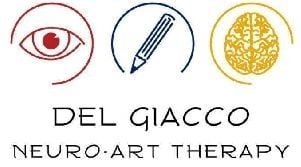
Type: Art Therapy
Location: Albany, NY, USA
Size: 1 Therapist
HappyNeuron Pro user since: 2021
The clinic was seeking a solution for exercising cognitive skills alongside art therapy techniques.
Art therapy has been used to help individuals process trauma, reduce anxiety and depression, and develop motor skills. Computerized cognitive training is used to stimulate different brain regions to sharpen the neural pathways responsible for complex cognitive functions. At Del Giacco Neuro Art Therapy, Maureen does both.

Maureen Del Giacco, PhD LCAT
Art Therapist
Based in Albany, New York, Maureen has been a practicing art therapist for over 29 years. She holds a PhD in creative arts therapy, an undergraduate fine arts degree, and is a certified reiki provider. In her practice, Maureen works with children and adults that have mental health, neurological disorders, and learning disabilities. With the fluidity and simplicity of art therapy, Maureen can see clients both in person and remotely. For Maureen, the “neuro” component of neuro-art therapy comes into play as she uses advanced art therapy techniques to help her patients develop and build cognitive skills impacted by different clinical disorders.
Maureen often sees patients that are struggling to comprehend what they are feeling. She has discovered that these individuals often have two underlying issues. The first is an unregulated sympathetic nervous system, and the second is cognitive deficiencies. An upregulated sympathetic nervous system means that these individuals often become stuck in “fight or flight” mode and may struggle to understand why they feel the way they are. Maureen introduces art as a way to help her patients learn to relax. Art therapy forces the individual to be present in the current moment. One cannot draw if they are distracted or under high stress. This is essential in her practice. By teaching her patients how to downregulate through mindful activities like creating art, she can help them relax, and thus, their bodies can start to heal or start to resolve internal conflicts. Once her patients understand how to down-regulate, Maureen can then start to introduce cognitive remediation and cognitive rehabilitation techniques.
Maureen has developed a technique to assess where an individual is struggling cognitively through drawing. This technique is known as Del Giacco Art Therapy (DAT).
“The basic premise is learning shapes again in the part of the brain where we learned them as children. I call that bottoms up. When you’re treating anxiety and depression which goes along with cognitive rehabilitation, you’ll want to incorporate something called modulation which goes from the bottom to the top. That brings in HappyNeuron Pro.”
As a survivor of brain injury, Maureen understands that brain connections need to be rebuilt, especially after experiencing a traumatic event. Using the Therapeutic Drawing Series (TDS) approach, Maureen works with her patients by taking a bottoms-up approach to rebuilding sensory pathways that are damaged post-injury or post-trauma. Using TDS, Maureen aims to help her patients address emotional distress that may inhibit cognitive functioning. With HappyNeuron Pro, Maureen’s patients build the foundations of essential cognitive skills in a digital environment that is easier on the nervous system. HappyNeuron Pro has a graphical interface that is designed to be easier on the nervous system, as complex graphics and bright colors can be difficult for patients with neurological disorders to interact with and process.
A common condition Maureen treats is ADHD. With ADHD, patients have anxiety that inhibits them from accessing the cognitive functions needed to succeed in an academic or professional setting. Maureen will have her patients perform an analysis of shapes (AOS) to help them practice skills such as planning and working memory while utilizing auditory processing and sensory processing to make a guided art exercise. This therapeutic technique may help patients be able to remember instructions needed to complete an activity, as well as think about the consequences of their actions before they take them. Viewing and using different colors can help calm the nervous system, which can improve cognitive functioning in patients with attention deficit and anxiety disorders.
“First, I use art therapy with them to calm them down. Especially to develop trust with them and assess where they are cognitively and what is the best way to proceed in therapy. Then maybe after 3-4 visits, I’ll say “let’s try HappyNeuron Pro”…[the clients] think it’s going to be very easy and silly why we are doing that. Then once they are [using HappyNeuron Pro] they go “Oh, this really makes me tired.” I have patients who are surprised that they’ve come out of their depression because of this process.”
The combined method of using art therapy and computerized cognitive training helps patients unlock and build pathways to process emotions better. While the computerized cognitive training helps clients rebuild neural pathways that are a part of the modulation needed for cortical processing of information; there is also the benefit for improving cognitive functions such as executive functioning, auditory processing and language. Neuroplasticity serves as the basis for the therapeutic procedure Maureen provides for her patients as the duration, intensity, and diversity of the therapeutic approach helps patients restructure and rebuild neural pathways.
Maureen sees patients for 45 to 90 minutes per session depending on the needs of the patient. HappyNeuron Pro is used after the 3-4 sessions as part of their home exercise program, but Maureen helps her patients if they have trouble during one-on-one sessions if needed. Therapeutic duration varies from person-to-person as people may undergo therapy for 3-months to two years, but may also leave therapy and come back as new challenges come in. As the client’s needs evolve, so does their need for therapy. At every stage, Maureen adapts her approach to therapy to target the psycho-emotional and cognitive needs of her patients.
“I thought “Let me try HappyNeuron Pro and see what happens.” I was pleasantly surprised, and so were my clients because it is much easier on the nervous system. The data is much simpler to use. It’s more user-friendly. They like the feedback they get from there”.
HappyNeuron Pro combined with art therapy to help patients rebuild cognitive skills while understanding their emotions better.
An adaptable, multi-faceted approach to help patients regain cognitive function and rebuild mental health.
Pulling from our decades of experience in Cognitive Therapeutics, we aim to help you enrich your practice through the use of digital and paper tools.
Pricing + Offers


© 2023 HappyNeuron is a Product of Humans Matter